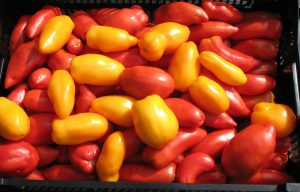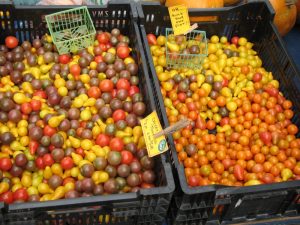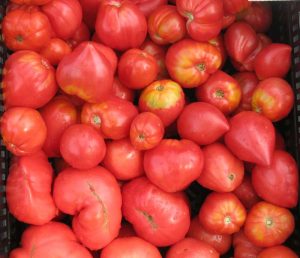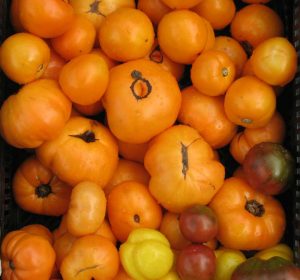Our Tomato Varieties
for the 2021 growing season
Also see our Tomato Growing Tips at the bottom.
Many of these seedlings are available at our online store during the planting season. All varieties are available at the farm or at our farmers’ market locations.
Order these for pickup between May 15 and June 20.
From mid May to late June, we offer a wide range of tomato plants for your garden, greenhouse, or container. Our heirloom and hybrid varieties are mostly from local seed companies or developed by us on our farm, so may not be familiar to you. Here we offer variety descriptions and planting suggestions which we hope will help you grow exactly the tomatoes you would like to see in your garden. Note: These seedlings and are only available at the farm or at the farmers’ markets we attend (Orono, Pittsfield, Waterville, and Unity). To order tomato seeds visit our Seeds For Sale page.
All 6-paks and 3-paks are $4.00. Singles are 2.00 ea. or 6 for $9.00. Not all varieties available in all sizes.
KEY:
* = We saved our own organically grown seed.
F1 = Hybrid.
OP = Open Pollinated (not a hybrid).
OG= Organically Grown seeds.
Letters in [BRACKETS] indicate what the label in your plants will say.
Tip: Save your plant labels so you’ll know what to ask for next year
–——–—-——–——–—-——–——–—-——
PASTE TOMATOES.

Tomatoes with less juice and more meat. Good for salads, salsas, sandwiches, or for tomato sauce. Available in 6-packs.
Hogheart. [HH] *OP An heirloom paste tomato we have been saving seed from since 1985. Five to seven inches long and pointed, hogheart is the size of a banana, with excellent flavor, fresh or cooked. Very good for sandwiches, sauces, or drying. Indet. Late August.
Snakeroot Golden Arrow. [SGA] *OP. OG. Det. A long golden very firm and dry paste tomato that we have been developing ourselves for over 12 years. Very heavy yielding. Early Sept. A Snakeroot exclusive variety found nowhere else. Great for sandwiches & salsas, too.
San Marzano. [SAN MARZ] F1. Indet. 80 days. Produces heavy yields of long cylindrical fruit with delicious balanced flavor & meaty flesh. A little larger than Roma, but much smaller than Hogheart. Developed in Parma, Italy, for the canning industry in the 1950s. Disease resistant plants are vigorous, strong and heavy yielding. Thick walled, meaty tomatoes with deep red color.
–——–—-——–——–—-——–——–—-——
CHERRY TOMATOES. All of our cherry tomatoes grow large plants with grape-like clusters of fruits. Though not especially early, any of them will give you the keys to tomato heaven! All are indeterminate. Available in 6-packs.

Yellow Pear Cherry. [YP] *OP. A teardrop shaped indeterminate heirloom, grows up to ten feet high trellised in our greenhouse. A flavor and color treat.
Red Pear Cherry. [RP] *OP. Like Yellow Pear, only red, and fruits tend to be somewhat larger and more tomato flavored. Pear shaped cherries are less prone to splitting in wet weather.
Gardener’s Delight. [G.Del] *OP. An indeterminate heirloom producing one-inch round fruits of outstanding rich sweet flavor. Tendency to crack. Not Available in 2021.
Peacevine. [PV] OP. A rampant indeterminate selected from the offspring of Sweet 100, having similar fruit size and growth habit. One inch round red fruits with a rich sweet-tart flavor derived from its current tomato heritage. High in Vitamin C. Peacevine is this year’s substitute for Gardener’s Delight, which is unavailable.
Sungold. [SG] F1. Bright tangerine orange with intense “tropical” flavor. Large indeterminate plants produce early and continue thru season. Tendency to crack, but flavor is worth it.
Black Cherry. [BC] *OP. ¾ inch dark purple cherry tomatoes with mahogany color tones. Sharp smoky and delicious tomato flavor.
Snakeroot Long Pink. [SLP] *OP. Indet. An offshoot of the Pink Princess and HoneyDrop lines, these large, long grape-shaped cherry tomatoes are equally delicious as their forebears. Another Snakeroot Organic Farm exclusive variety.
Snakeroot Long Yellow. [SLY] *OP. Indet. An offshoot of the Pink Princess and HoneyDrop lines, these large, long grape-shaped cherry tomatoes are equally delicious as their forebears. Another Snakeroot Organic Farm exclusive variety.
–——–——–——–——–——————————

EARLY TOMATOES. Who can wait for that first tomato picked from the garden? Although by the end of the season they are not the most prolific of producers, early varieties are the first to provide you with that long-awaited treat. Available in 6-packs.
Moskvich. [MOSK] *OP Cold tolerant indet. heirloom, a real taste treat. Good sized early juicy tomatoes are usually the first tomato we bring to market. Moskvich starts producing large tomatoes, and keeps up until frost with gradually diminishing sizes, but still good flavor. Mid Aug.
Jetstar. [JET] F1 Ind. High yielding round red tomato for field or greenhouse. Half pound fruits have excellent flavor. Mid August.
Frosty’s Heart. [FH] *OP. An Italian heirloom pink heart-shaped tomato, second early, prolific. Medium sized, smooth silky texture. Mid August.
–——–—-——–——–—-——–——–—-——
COLORED HEIRLOOM TOMATOES. More varied tomatoes than you’ll ever find in a store, with a wide range of shapes, colors & flavors. Available in 6-packs.

Pruden’s Purple. [PRU] *OP. An indeterminate heirloom producing large irregular pink fruit about two weeks earlier than Brandywine, which it resembles. If you like tomato sandwiches, this is the one you want. Prone to cracking in wet seasons. Potato-leaved. Late August.
Lillian’s Yellow. [LIL] *OP. This indet. heirloom grows very large rich tasting lemon yellow tomatoes, some irregular, some perfect. Less acid than red varieties. A pretty addition to salads. Potato-leaved. Originated by Lillian Bruce of Tennessee. Early Sept.
Tangerine. [TANG] *OP. OG. 85 days. Indet. Round, smooth, 8-10 oz orange tomatoes, high levels of beta carotene for nutritional boost. Heavy producer. Meaty interior, few seeds.
Brandywine. [BW] *OP. The benchmark for real tomato flavor. Indeterminate, potato-leafed. Pink, large, thin skin, meaty fruit, produces better in cool weather. Early Sept.
Yellow Brandywine. Indet. 85 days. A dark yellow version of Brandywine. A sandwich-covering delicious low-acid tomato. Early Sept.
Paul Robeson. [PR] *OP, OG. Indet. Russian heirloom 6-16oz. oblate coffee colored tomato similar in taste to Black Krim with its own unique smokey flavor. Tangy sandwich tomato. Late August.
Black Krim. OP *OG. Indet. Smokey, juicy flavor. Average one pound fruits are ripe when shoulders are still green. Heavy producer.
Copia. Indet. 85 Days. *OP. OG. Fine stripes of candy red and golden yellow inside and out, this tomato averages just under a pound each.
Barred Boar. *OP, OG. Indet. Medium large alternating metallic “paint-splashed” green and pink-brown striping. Meaty beefsteak pink interior is very flavorful.
Solar Flare. *OP, OG. A 6-10 oz. red beefsteak tomato with gold stripes, meaty with great flavor. A real producer.
–——–—-——–——–—-——–——–—-——
BIG ROUND RED for those who just want a medium to large“regular” tomato from their garden. Available in 6-packs.
Beefsteak. F1. OG. Indet. Flattened red 1-2 lb. fruits, meaty dark red flesh, excellent full flavor. Vigorous, very productive. Late Aug.
Big Beef. [BB] F1. Indet. Workhorse producer of near-perfect 10 oz red beefsteak tomatoes. Wide disease resistance. Large, vigorous vines. Mid August.
Celebrity. [Cel] F1. Det. Vigorous producer of half pound round red tomatoes with good flavor. A long popular favorite of gardeners.
Mt. Fresh. [MT FRESH] F1. Det. 75 days, big round red tomato, 8-16 oz., able to tolerate cool and wet conditions.. Mid Aug. The most widely-grown market tomato in the East and Midwest. Able to tolerate cool and wet conditions, this big red tomato produces attractive, 8-16 oz. slicers with good flavor. Developed by Dr. Randy Gardner at North Carolina State University. Vigorous plants provide plenty of leaf cover. High resistance to fusarium wilt races 1, 2, nematodes, and verticillium wilt. Determinate.
–——–—-——–——–—-——–——–—-—
We’ll also have small quantities of other varieties during late May and June. Ask us about them at market.
–—————––—————–
Tomatoes are warm loving plants that will be killed by frost, but will survive OK in chilly weather or if nights regularly go below 40°F, although they don’t like that. Some varieties are viney (indeterminate) while others are bushy (determinate).
If the seedlings are more than 6” tall, it is usually better to plant them more deeply than they currently are and to cover some of the lower stem with soil. Any stem planted below ground will grow more roots, and the less of the top that is exposed to the wind the easier it will be for the roots to support it. If the plants are really tall, you can even lay them down in a trench with just the top quarter of the plant sticking out above ground. For the first week the plant will be sprouting roots from its now-underground stem and the following week the top will really take off.
The biggest mistake most gardeners make when selecting tomato plants is to buy them by the size of the top rather than the size of the roots. Many tomatoes in garden centers have been daily fed synthetic fertilizers which results in a big green top but a very poor root system. From the plant’s point of view, there is no point in growing a lot of roots since the existing small root system is providing plenty of nutrition because of the daily feeding. The result is that when put out in the garden, these big-top/small-roots plants have to fend for themselves but don’t do very well because they need to have a robust root system that can reach out into your soil for nutrients. Therefore, be sure three is a good balance between your plant’s top and roots.
Protect your early tomato plantings with individual greenhouses or “cloches”, using either of these two low-cost methods:
1) Cut the bottom off a gallon milk jug, then slide it down over a stick stuck into the ground next to your tomato plant, so that the jug covers the plant. The stick keeps the jug from blowing off, and the jug provides several degrees of frost protection, plus warmer days and nights. Because the cover is not on the jug, daytime temperatures inside won’t get too hot. When the tomato outgrows the jug, danger of frost is likely past.
2) Place a tomato cage around your tomato as soon as you plant it. Then place a clear plastic trash bag over the tomato cage, using the prongs of cage to skewer the bag to the ground around the plant. Then cut a slit across the bottom of the bag (now at the top of the cage) and hold it open with clothespins. If a cold night is forecast, use the clothespins to close the opening at the top, but remember to open it again before mid-morning on sunny days to keep your plant from baking. The larger size of this cloche allows the protection to stay in place well into late June to protect the tomato plant from occasional chilly nights and cold windy days. For added protection include a few jugs of water inside to warm up during the day and give off heat at night.
–—————––———————————–
A word about tomato types.
There are several ways of classifying tomatoes. There are vine [indeterminate] vs. bush [determinate]. There are paste vs. slicing. There are regular vs. cherry. Some tomatoes are hybrids, others heirlooms. And of course, large vs. small.
Bush or vine?
Let’s first look at the way the plant grows. Tomato vines that keep on growing longer and longer until frost kills them are called indeterminate, because it is undetermined how long the vine will grow. These are often grown on a trellis (NOT just a cage!). They will typically get six or eight feet long during a season, and may have many productive suckers which may be pruned off for earlier and larger fruit. Plants which have vines that grow only a few feet before ending in a flower cluster are called determinate. They are smaller plants, but yield just as well, since they have productive suckers which grow a few feet before also ending in a flower cluster. And the suckers have suckers, and so on. Determinate varieties are often grown in cages to support them.
Trellising and caging are done to keep the tomato fruits off the ground, hence cleaner and less prone to insect or rodent damage. However, many folks [like us!] grow both kinds on the ground. Mulching the ground with plastic, leaves or hay keeps the fruit off the ground and helps retain soil moisture.
Paste tomatoes have less juice, making them easier to use for making sauces and tomato paste, since they cook down more quickly. However, their flavor is good as any, and their less juicy interiors make them ideal for sandwiches and salads. All our paste tomatoes are determinants.
Slicing tomatoes are “regular” tomatoes, real chin-wetters when you bite into them. They range from juicy ones like Moskvich and Jetstar to meaty ones like the beefstakes and the pastes.
Cherry tomatoes are a whole separate type of tomato, higher in sugars than non-cherry types. They are sweeter just before becoming fully ripe; more tomato-ey flavor when fully ripe. Generally ½ to 1 inch in diameter, cherries tend to grow in clusters like grapes. All our cherries are indeterminate types.
We refer to large tomatoes as anything larger than a baseball, some being large enough to more than cover a slice of bread. As a rule, larger tomatoes are later than smaller ones. Although there are important exceptions, small tomatoes (tennis ball to golf ball size) tend to ripen earlier and produce more fruit than larger varieties.
Heirloom tomatoes are varieties that have been handed down from generations of gardeners. Someone years ago discovered a great tomato and started a long line of seed saving that has lasted to this day. Since tomatoes tend to self-pollinate, there is very little cross-fertilization caused by insects, so it is easy to keep varieties distinct. You may save seeds from any variety labeled “heirloom” and know that next year you will get the same tomato. Almost all heirlooms are indeterminate.
Hybrids are varieties that have been purposely cross pollinated to produce offspring with a desired feature. Crossing is done by hand pollinating tomato flowers, making the seed somewhat more expensive. Hybrids are often referred to as “F1”, meaning first generation. Second generations of hybrids tend to go off-type, so saving a hybrid’s seeds will give a wide range of tomatoes.
–—————––———————————–
We’ll have Tomatoes.
In case you need more tomatoes than your garden produces, we will have tomatoes at market and at the farm from early August until late October. We grow all the varieties listed here, plus a few more. Tomatoes for canning will be available from mid August to mid September, and we’ll be bringing canners to market as soon as they are ready. We offer both “all red” canners and “mixed heirloom” canners. Our canners are tomatoes that are over-ripe or have slight defect (though usually not splits) and we offer them at a deep discount over our #1 tomatoes. Beginning every mid-August we begin drying our tomatoes as well, and offer these in 3 oz. bags. Generally we separately dry several types: Hogheart tomatoes, mixed yellows, mixed pinks, and mixed reds. Try them all to discover your favorite.
–—————––———————————–
You can find us…
…during the Market season at these locations:
Orono Farmers’ Market, Saturday 8am–noon and Tuesday 2–5:30pm at the Steam Plant parking lot on College Ave.
Pittsfield Farmers’ Market, Monday and Thursday 2–6pm at Hathorn Park.
Unity Farmers’ Market, Saturday 9am–1pm at the Community Center on School Street.
Waterville Farmers’ Market, Thursday 2–6pm on the Common St. opposite City Hall..
…and of course at the farm.We are at the end of the Organic Farm Road, ½ mile down the Snakeroot Road from the Higgins Road end. Complete directions and GPS are on our website. Come see how we grow tomatoes and cherry tomatoes in our fields and greenhouses during our Annual Farm Tour on the second Sunday in July, from noon to 4pm.
–—————––———————————–
Seeds
We also have our own home-grown tomato seeds available for all the varieties marked with an asterisk. Tomato seeds remain viable for five or more years, so a packet purchased this year will produce seedlings for you for several years to come.
